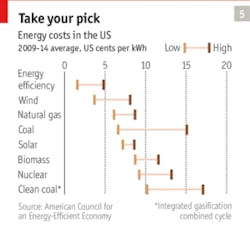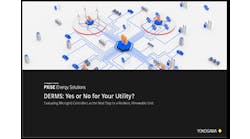People in energy policy circles tend to talk in relatively biased terms when it comes to energy efficiency. The conventional wisdom is that energy efficiency is massive, simple and cheap:
“The ‘fifth fuel’, as energy efficiency is sometimes called, is the cheapest of all. A report by ACEEE, an American energy-efficiency group, reckons that the average cost of saving a kilowatt hour is 2.8 cents; the typical retail cost of one in America is 10 cents. In the electricity-using sector, saving a kilowatt hour can cost as little as one-sixth of a cent, says Mr. Lovins of Rocky Mountain Institute, so payback can be measured in months, not years.”
The implication (intended or not) of this is that efficiency is the “low hanging fruit” and we don’t need to pay attention to policies and incentives of energy efficiency compared to solar, wind and other forms of clean energy.
And so while, for example, solar power receives government and utility incentives that represent $10,000 or more per home (30 percent + of a $30k system), energy efficiency receives far less (typically $2,000-$3,000 per home for a much smaller project in an equivalent whole-house project).
But while the overall story of efficiency as the cheapest energy is true, the actual costs and benefits of energy efficiency tend to be obscured and sometime exaggerated.
There are a few key factors that drive this:
1. The “cost” of energy efficiency is the incentive cost
The “cost” of energy efficiency in reports and analyses by ACEEE and Lazard are the incentive cost per energy unit saved (typically kWh), not the actual cost of the measure. So, if a utility company gives a rebate of $100 for a more efficient refrigerator that saves 1000 kWh/year and lasts for 10 years, then the energy efficiency “cost” is $0.01/kWh even though the full cost of the refrigerator was $1,000 not $100 (or $0.10/kWh).
With a few exceptions (see below), these rebates cover part but not at all of the cost of energy efficiency measures. New York, for example, covers 10 percent of all qualified energy efficiency improvements while Massachusetts covers 75 percent of improvements up to a cap. This means states and utilities are not just simply building energy efficiency power plants, but must also have consumer participation.
On the other hand, solar, wind and, other energy sources are calculated just based on the actual costs to produce the energy (the $1,000 equivalent in the example above). If the cost of the energy is less than alternatives (and/or less volatile), then it’s a pretty simple cost-benefit equation, as we’ve seen with the fast adoption of solar in the last few years.
Energy efficiency is different. As we’ve discussed at length on the Sealed blog, most people don’t believe in the energy savings and therefore discount them heavily. This is the problem we are Sealed are trying to solve.
But on the other side of the ledger, energy efficiency has major “non-energy benefits” – policy lingo for the physical value the improvements create. This ranges from the comfort benefits of insulation and air sealing, to health benefits for a more efficient boiler, and the control from a smart thermostat. And while some policymakers are trying to “quantify” these benefits, they are ultimately valued by each individual consumer differently.
Or as the National Action Plan for Energy Efficiency (NAPEE), the closest thing we’ve had to national energy efficiency guidelines, puts it:
“This [cost-effectiveness] estimate would be termed the ‘program administrator cost’ for the saved energy; because customers typically pay a substantial portion of total efficiency investment costs, the ‘total resource cost’ of these savings would be higher than 2 cents.”
2. Current efficiency cost estimates are inflated by lighting
The 2 to 3 cents/kWh cost for energy efficiency that is regularly thrown around is also heavily biased towards lighting, which make up a large percentage of total savings via state and utility programs.
NSTAR (now part of Eversource, a Massachusetts utility, is a typical example (not picking on any one utility) that demonstrates this point. NSTAR gets almost 60 percent of its residential lifetime electricity savings from lighting at a cost of about $0.04/kWh saved. Lighting, however, only makes up 20 percent of total residential program costs, with an average cost of $0.12/ kWh saved.
And even this obscures the scale of lighting, as many of the other “whole home” programs include lighting to get many of their savings. The main reason this occurs is that lighting programs are a lot easier for consumers to adopt because most of the time the “program” is giving away light bulbs for free.
Another way of looking at it is that energy efficiency programs have successfully given away free stuff (slow clap…), but have many more challenges with driving cheap savings via discounts on more expensive items (insulation, HVAC systems, etc.)
So lighting is a really cheap, easy form of energy savings. And that’s not a bad thing!
But it does mean that almost all economic analyses of energy efficiency are heavily weighted towards one technology, and that the remainder are not nearly as cheap when analyzed in a one-dimensional manner.
3. There are lots of other financial benefits from energy efficiency
Policy folks tend to simplify cost-benefits to a single fuel (usually electricity in kWh). And this makes sense from the perspective of a single utility that only delivers that fuel. But the reality is that most people use electricity and a heating fuel (natural gas, heating oil, etc.), and many efficiency improvements impact both of these fuels.
So the apples-to-apples comparison of the cost of energy efficiency to other fuels is the lifetime energy savings compared to the cost of a project.
If you improve your home by installing new insulation, sealing air leaks and installing a new Nest thermostat, it might cost $5,000, with $300 of electric savings per year and $700 of heating oil savings per year. That could mean electric savings effectively cost 14 cents/kWh and heating oil savings cost $2.50/gallon.
There are also other utility benefits from reducing load (particularly peak load) that are quantified as an “avoided cost of energy” (e.g. $0.07/kWh saved). Utilities use these calculations to determine what rebates and incentives are offered, which can buy down a project from $5,000 to $4,000, for example.
Unfortunately, these avoided costs are not passed on transparently and simply so consumers rarely receive the right price signals on which improvements will lead to the most grid benefits.
At the end of the day, energy efficiency is still usually cheaper than supply (both from the utility and consumer perspectives), but it is not as cheap as popular mythology.
That said, all that utilities and policymakers need to do is send the right price signals, and simply pay less than it costs to procure energy (i.e. avoided cost of supply). That doesn’t require all sort of crazy program structures, but rather simple negawatt incentives tied to actual, metered savings.
And even in the cases where energy efficiency is not cheaper for consumers, there are plenty of other good reasons to make energy-saving home improvements. And they will be more likely to make them if they receive the right price signals from policymakers via simple mechanisms tied to actual savings.
But if we want to have an intelligent conversation on the subject and create rational public policy, everyone needs to start making apples-to-apples comparisons to other energy sources rather than just cite old studies that reflect the economics of subsidies to a single technology and a single fuel.
Andy Frank is founder and CEO of Sealed. This blog originally appeared on Sealed’s website.







